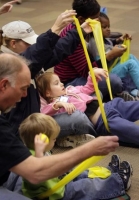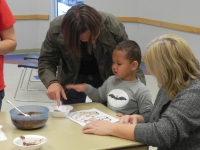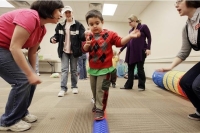Transforming Library Storytimes for Children with Sensory Integration Challenges
Tulsa City-County Library, Okla.
Innovation Synopsis
Public libraries can be a powerful partner in education, socialization and literacy for families with children with autism and sensory integration challenges. Tulsa City-County Library’s Sensory Storytimes and their impact on these families is an example of a library rethinking its approach to being a welcoming and inclusive venue.
Challenge/Opportunity
TCCL strives to be a welcoming place for all members of our community. Each month, TCCL offers hundreds of programs for children, teens, adults and seniors at our 26 locations. In recent years, TCCL has had many requests from families to create inclusive children’s programming that meets the social, environmental and educational needs of children on the autism spectrum. In 2012, TCCL designed a Sensory Storytime program to meet this very important need in our community. The goals of Sensory Storytime are to provide free, inclusive, interactive programming for children with sensory integration issues and their peers, and to provide to facilitate parent-to-parent support. Sensory Storytime combines books, songs, movement and therapeutic activities into a program that stimulates all five senses and promotes learning. It is especially designed for children with a variety of learning styles. Developing Sensory Storytime also provided the library an opportunity to reach out to community organizations that offer services and resources for families of children with autism and sensory integration challenges. Several strong new community ties were made during the development of the program.
Key Elements of Innovation
Taking Sensory Storytime from a vague idea to a relevant and functional program took months of planning and partnership. Judy McCarter, occupational therapist and consultant on sensory integration, was an essential resource in the formation of the TCCL Sensory Programming Planning Committee. This group of nine children and teen library associates came together to create, learn, and share. The committee’s first task was to assess the need for local sensory programming. They designed a survey which was distributed to library users and through The Autism Center of Tulsa and The Little Lighthouse. Of the respondents, 54 percent had never attended a library storytime and several responded with very specific examples of activities, resources, and even room set up for sensory programming (eliminate extra chairs, posters and distractions; dim lighting). Responses from the survey were used to design a structure for sensory programming. The committee researched sensory programming at public libraries and considered local customization. They spoke with professional educators, therapists, and parents, and toured some local sensory settings. The Autism Center of Tulsa participated in planning, research, and promotion throughout the development period. The committee created a Sensory Storytime pilot and developed program tools: resource lists, how-to guides, sample schedules and a template for visual guides to individual libraries. A kit of resources for Sensory Storytime was established with therapeutic seating, a visual schedule, fidgets, therabands and other supplies. In March 2012, Sensory Storytime opened for registration. Sessions were designed for 12 children, ages 1 to 7, accompanied by caregivers. Registration was online, and parents and children were given access to a visual guide to the hosting library to prepare them for storytime.
Achieved Outcomes
The initial series of Sensory Storytime programs met with great success. Children and parents enjoyed the opportunity to participate in a social, judgment-free activity promoting inclusion and education. After each storytime, participants were emailed a post-survey to collect feedback on their experience and for recommendations on improvements to the program. Of those surveyed who had attended a previous library storytime, almost 100 percent said Sensory Storytime is more effective for their child: “I am so grateful for this program and hope it continues. It is great to be able to go and not worry other kids will be distracted by your child.” One parent noted she often brings her children to storytime programs and Sensory Storytime was a little different. "There are more tactile items, more sensory stuff and more interaction with other kids." Since the initial pilot, additional branch libraries have offered Sensory Storytimes. Eleven sessions have been held across the system from April 2012 through March 2013, with a total of 196 participants. With each post-survey we continue to learn about new toys, resources and activities we can incorporate, about better times of day and even days of the week. The planning committee was asked to present at the 2012 Oklahoma Statewide Autism Conference. Members of the planning committee along with Judy McCarter presented “Sensory Storytime @ Your Public Library” to an enthusiastic crowd, all then eager to encourage their local library to offer sensory programming. The Autism Center of Tulsa named TCCL a 2012 Outstanding Community Partner.



